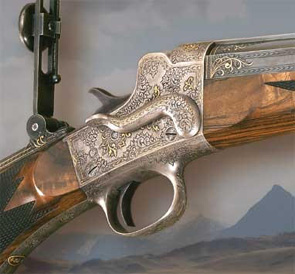

 The Accurate Reloading Forums
The Accurate Reloading Forums  THE ACCURATE RELOADING.COM FORUMS
THE ACCURATE RELOADING.COM FORUMS  Rifles
Rifles  Single Shot Rifles
Single Shot Rifles  Re: Shilo BPCR questions
Re: Shilo BPCR questionsGo  | New  | Find  | Notify  | Tools  | Reply  |  |
| one of us |
I "had" a 45-120. Biggest mistake I made. I had to down load it to 100-110 grains to make it shoot good, so what's the good of that long case (it is very "cool looking"), which by the way, is VERY expensive. I now have 2 45-100's which shoot great are easy to load for, low fouling, brass is MUCH cheaper. I did like shooting 120 and if you're only shooting once in a while and don't mind the pointed out fault's, go for it, but I think you will regret it.  Another option is buy a 45-100 and if you want later, ream it to 110 and if needed out to 120. This way, you will get a better "first taste". Doz | ||
|
| new member |
And also (for realism's sake) the Sharps company NEVER chambered their rifles for anything larger than .45-2-7/8" (.45-110) and .50-2.5" (.50-90 aka, "Big 50"). Being the owner of a 17+# BPCR (Rolling Block) in .45-2.6" that has its authentic crescent buttplate, shooting the .45-100 really lets you KNOW when you touch it off! And it is a much heavier than "standard" rifle! No offhand shooting with this one! If it had a Shotgun style buttplate it wouldn't be nearly so noticeable. If he really likes SHOOTING a lot, I'd go with a .45-70 or .45-2.4" and just enjoy it. | |||
|
| one of us |
You started a nice post, thanks. In the long distant future I'm thinking a 50-90 would make a good BPCR to play with - the 45-70's big brother as I see it. I've shot a 50-140 and it is most impressive. Clouds up the range, sets me way back on the bench, and it REALLY sets our 440-yard gong swinging. The case is something to behold. It really gets some attention, especially from the AR/AK crowd. It sounds like the 45s or 50s would make a good project for your uncle. From your posts and all the responses I see a good match between an adventurous reloader and a difficult cartridge. | |||
|
| new member |
Two really good ones (indispensable in fact) are "The Blackpowder Cartridge Loading Primer" by Steve Garbe and Mike Venturino, AND Mike's newest book, "Shooting Buffalo Rifles of the Old West". This last one includes lots of insight into all kinds of rifles and calibers your uncle would probably be interested in, while the first book mentioned is more of a recipe book of handloading BPCR cartridges. | |||
|
| one of us |
Thanks for all of the help and info. He is really getting into this. He is talking with several dealers and a few folks who are reps for the makers of several models. He is the type to go at things methodically so I am excited to see what all he comes up with. Thanks again Coues Derrick Stone | |||
|
| new member |
Also, one other thing I forgot to mention is the general concensus of BPCR shooters these days feel that cartridges using more powder than the .45-100 experience problems with hard fouling. This probably has more to do with the powders available to us these days than some of the premium blackpowders available in the 1870s-early 1900s. (Such as the English made Curtis & Harvey "Diamond Grade" powder) Apparently much of that has to do with the types of wood available then vs. now for using to make charcoals out of. Some of the premium blackpowders from yesteryear used charcoals that were higher in moisture content than what's available these days, and the fouling remained softer using those large loads of powder. The hard fouling left in the bore affects accuracy adversely. | |||
|
| one of us |
Mr. Bill_C_sbio , Thank you for the help and info. He has started to buy books for reloading, info as well as history. Is there any that you would recommend. In talking to he has made a lot of calls to some folks and has decided on a 45-110 and a 50-110. He is semi retired and is wanting to expand on his hobbies. Thanks again. Coues | |||
|
| Powered by Social Strata |
| Please Wait. Your request is being processed... |
|
 The Accurate Reloading Forums
The Accurate Reloading Forums  THE ACCURATE RELOADING.COM FORUMS
THE ACCURATE RELOADING.COM FORUMS  Rifles
Rifles  Single Shot Rifles
Single Shot Rifles  Re: Shilo BPCR questions
Re: Shilo BPCR questions

Visit our on-line store for AR Memorabilia

